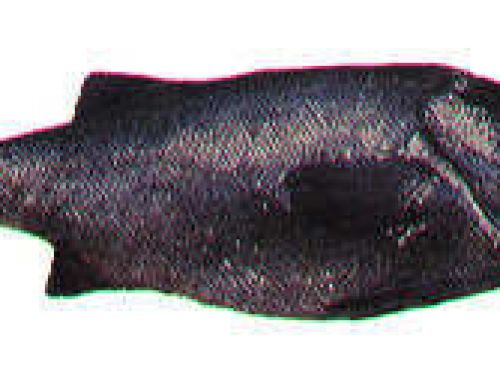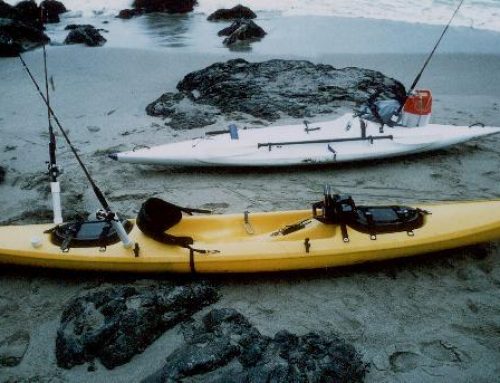Canary and Vermilion and Yelloweye…oh my!
by Jayna Schaaf-DaSilva, Marine Biologist (article harvested from CDFG Bulletin)
One of the most diverse and successful groups of fishes in the eastern Pacific is the rockfishes (genus Sebastes), represented by more than 60 species in California waters. All rockfishes have a set of characteristics that distinguish them from other fishes, most notably the prominent head spines. Rockfishes have five spines on the rear cheek area, a continuous dorsal fin with 12–15 spines and 9–16 soft rays, and an anal fin with three spines and 5–9 soft rays. Rockfishes are generally long-lived, slow growing, late maturing, and mostly residential fishes.This combination of characteristics makes rockfishes extremely vulnerable to overfishing.
In addition to these life history characteristics, increased fishing pressure and unfavorable oceanic conditions have combined to reduce some populations of rockfish to extremely low levels. Two examples of important species under pressure are the canary (Sebastes pinniger) and the yelloweye (Sebastes ruberrimus) rockfishes. Canary rockfish have a potential lifespan of 60 years or more, while the yelloweye rockfish can live to be at least 118 years old. They mature relatively late in life. NOAA Fisheries has designated these species as “overfished” and the federal Groundfish Fishery Management Plan mandates actions to rebuild their stocks to a healthy condition in the shortest time possible. In order to allow these stocks to rebuild, it is illegal to keep individuals of these species. Stocks are not expected to be rebuilt until 2017 and 2074, respectively. Unintentionally caught canary or yelloweye rockfishes should be returned to the water immediately to increase their chances of survival.
It can be challenging to identify any rockfish species, including prohibited species, when many of them are the reddish-colored and look very similar. In the past, anglers have typically misidentified canary (a prohibited fish) as vermilion rockfish (a permissible fish). The best way to distinguish a canary rockfish is by the bright orange coloration. The color can be compared to that of a road construction cone, a soda can of orange Crush®, or a bowl of Cheetos®. In northern California, the orange color pattern may be more reddish. However, all canary rockfish have a broad white or light grey band along the lateral line of the body that extends from the head to the tail. Canary rockfish also have a white belly, a slanted triangular-shaped anal fin, and a slightly forked tail fin. In smaller individuals, a dark grey or black spot can often be found at the base of the dorsal fin, about halfway down the body. When all else fails, rubbing the thumb against the chin of the fish will give a clue; canary rockfish have a smooth jaw.
Vermilion rockfish are actually quite distinct from canary rockfish, once one knows what to look for. Vermilion rockfish possess a much deeper red color: envision the red of a very ripe tomato. Vermilion rockfish lack the broad white or grey band on the body, but may have a partial band, and the belly is never bright white. The anal fin is rounded in vermilion rockfish, and the tail fin is straight. Many individuals have black borders on the fins. The upper (dorsal) part of the body is mottled with dark grey to black speckles, especially in younger fish. Again, rubbing the chin of the fish can help distinguish it; vermilion rockfish have a sandpaper-like roughness to the chin.
Some anglers misidentify yelloweye (a prohibited fish) as vermilion rockfish (a permissible fish). Yelloweye rockfish reach a larger maximum size than either canary or vermilion rockfishes, and they have very big, strong head spines. The yelloweye rockfish goes though a rather dramatic color change with growth. Juveniles are reddish-orange with two solid white lines running the length of the body, one along the lateral line and one below it. During transition, the body is red with only one white stripe (the bottom stripe disappears first). Large, mature individuals lack the white stripes completely, and are more orange-colored with pinkish fins. The fins are tipped with black throughout growth. The yelloweye rockfish, not surprisingly, has prominent golden-yellow eyes. There is a rasp-like ridge of spines above the eyes of large individuals. Like the canary rockfish, the chin of the yelloweye rockfish is smooth.
With practice and patience, identifying the characteristics of canary, vermilion, and yelloweye rockfishes can become a straightforward task. A combination of characteristics such as the coloration of the lateral line, shape of the fins, chin texture, and body color can be used to identify each species of these three “red” rockfishes. Proper identification is the key to reducing the accidental harvest and ultimately rebuilding the California stocks of overfished species in a minimum amount of time.
For more information about canary, vermilion and yelloweye rockfishes, visit the following Web sites:
- Frequently Asked Questions Regarding the Oct 1, 2007 Recreational In-Season Groundfish Closure of the Northern and North-Central Management Areas: www.dfg.ca.gov/marine/groundfishcentral/pdfs/faqs_groundfish.pdf
- A Primer on Groundfish: www.pcouncil.org/groundfish/gfprimer.html
For full-color illustrations of these rockfishes, click here.


